Philippines
Embark on a sensational journey as you travel to the Philippines, an archipelago of more than 7,000 islands awash with breathtaking natural beauty and vibrant cultural tapestry. Imagine the gentle whisper of the salty breeze as you set foot on the powdery white sands of Boracay, where azure waves kiss the shoreline beneath radiant golden sunsets. Savor the tangy delight of freshly picked mangoes and the rich aroma of sizzling adobo, tantalizing tastes that define the rich culinary mosaic that awaits you in every bustling marketplace. Allow the lively rhythms of the traditional “tinikling” dance, where dancers gracefully leap over bamboo poles, to echo in your spirit. As you venture deeper, explore the ancient rice terraces of Banaue, where layers of emerald spread across the rugged terrain like a master artist’s canvas. The enchanting sounds of exotic wildlife harmonize with the gently rustling leaves of lush rainforests. The Philippines is not just a destination; it is an intoxicating blend of sensory wonders that captures the essence of tropical paradise, urging every traveler to uncover its secrets and endlessly compelling landscapes.
Philippines Travel Season
Traveling to the Philippines offers a wealth of experiences, boasting picturesque beaches, lush jungles, and vibrant city life. The best time to travel to the Philippines largely depends on the type of experience you seek, but generally, the dry season from November to April is the ideal window, featuring the most favorable weather conditions for a variety of activities. During these months, visitors can enjoy sunshine, balmy temperatures, and minimal rainfall, perfect for exploring the country's many islands and engaging in outdoor adventures.
The peak travel season in the Philippines spans from December to February, aligning with the country's dry season. During this time, tourists flock to popular destinations like Boracay, Palawan, and Cebu, seeking to experience their idyllic beaches and crystal-clear waters. Although this period ensures great weather for outdoor activities, it also comes with increased crowds and higher prices for accommodations and flights. The Christmas and New Year holidays are especially busy, as both locals and international tourists join in festive celebrations across the country.
Ideal Travel Times
For travelers who wish to enjoy a balance between favorable weather and fewer crowds, the shoulder months of November and early March are ideal for travel to the Philippines. During these times, the islands begin to experience the transition into the dry season or still offer lingering benefits from it, generally bringing milder temperatures and dry conditions without the dense crowds typical of peak season. Beyond comfortable traveling conditions, you might also score some deals on hotels and flights, making it a cost-effective period for your trip.
Off-Peak Perks
Travel to the Philippines during the off-peak season, which falls between June and October, offers its own set of unique advantages. While this period coincides with the wet season—a time characterized by tropical rains and occasional typhoons—it is also when the country truly breathes, with fewer tourists around. It's an excellent time for budget-conscious travelers, as accommodations and activities tend to be more affordable. With persistence, travelers can still find pockets of sunny weather suitable for exploring; destinations to the south such as Davao and Cebu are relatively drier than northern areas during this season.
Local Events and Holidays
The Philippines hosts numerous vibrant festivals throughout the year. In January, the Sinulog Festival in Cebu and the Ati-Atihan Festival in Aklan attract visitors with their colorful parades and captivating dances. Since these events coincidentally align with peak season, attending these showcases of Philippine culture can be a highlight of any trip. Meanwhile, the Pahiyas Festival in May, celebrated in Lucban, Quezon, marks the local harvest season with decorated houses and lively donations. Experiencing these festivals allows travelers to immerse themselves in local culture, regardless of the season.
When planning travel to the Philippines, consider what aligns best with your interests, whether it's lounging on serene beaches, engaging in local culture, or exploring the diverse landscape without breaking the bank. Each season presents its own allure, offering an array of Filipino experiences for any traveler. Tailoring your travel plans to the seasonal nuances will ensure an unforgettable journey through this tropical paradise.
The Weather and Seasons in Philippines
The weather in the Philippines is characterized by a tropical maritime climate, inviting travelers to enjoy its warmth and beauty all year round. The climate is generally divided into three main seasons: the hot dry season, the rainy season, and the cool dry season. This climate pattern shapes the travel experiences in the Philippines, with varying temperatures, humidity levels, and rainfall influencing the best times to visit different parts of the country.
Hot Dry Season
From March to May, the Philippines experiences its hottest months. During this period, temperatures can soar to around 95°F (35°C) particularly in areas like Metro Manila and other lowland regions. This season, often referred to as "summer" in the local context, offers travelers sunny skies perfect for beach trips and island hopping adventures. Humidity, however, can be quite high, and it's advisable for visitors to stay hydrated and apply sunscreen generously.
Rainy Season
The rainy season in the Philippines typically spans from June to November. This period is marked by increased rainfall and occasional typhoons, particularly affecting the Luzon and Visayas regions. Temperatures during this season range from 77°F to 90°F (25°C to 32°C). While travel plans could be disrupted by heavy downpours, those who venture during this time can enjoy lush, green landscapes and fewer crowds at popular tourist sites. It's a good idea for travelers to check weather forecasts regularly and have a flexible itinerary.
Cool Dry Season
From December to February, the Philippines welcomes the cooler dry season, which many consider the most favorable time for travel. During these months, temperatures drop to a more comfortable range of 68°F to 86°F (20°C to 30°C), making it ideal for exploring both urban and rural areas alike. This season is characterized by lower humidity and pleasant breezes, creating perfect conditions for outdoor activities and festivals. Travel to the Philippines during this time is highly recommended due to the welcoming climate and vibrant local events.
Travelers to the Philippines can expect varied weather conditions depending on when they visit and which regions they explore. The diverse weather also brings about local festivals and events tied to agrarian cycles and regional traditions. For instance, colorful festivals such as the Sinulog in Cebu and the Ati-Atihan in Aklan take place during the cooler months, offering a glimpse into the rich cultural tapestry of the Philippines.
For those planning to travel to the Philippines, monitoring local weather patterns and planning accordingly ensures a more enjoyable and smoother experience. The interplay of warm temperatures, tropical rains, and cooler breezes throughout the year provides a unique backdrop for gleaming beaches, stunning landscapes, and thriving cities, making the Philippines a desirable travel destination all year round.
Accepted Payment Methods and Other Payment Information in Philippines
When planning your travel to the Philippines, understanding the payment options available can help make your trip smoother. The official currency used throughout the Philippines is the Philippine Peso (PHP). It’s essential for travelers to become familiar with local currency as it is widely used, especially in smaller towns or rural areas. Currency exchange services are accessible at airports, banks, and authorized money exchange centers, making it convenient for travelers to acquire Pesos during their travel to the Philippines.
Credit cards such as Visa, Mastercard, American Express, and Discover are commonly accepted in urban areas across the Philippines. Hotels, shopping malls, restaurants, and large businesses generally accept these major credit cards, making it easy for travelers to conduct transactions without needing to carry large amounts of cash. However, it’s important to note some limitations; American Express and Discover may be less commonly accepted compared to Visa and Mastercard, especially in provincial regions and smaller establishments where cash transactions are preferred. Travelers should ensure they have a backup payment method if their primary card is not accepted.
For those traveling to the Philippines, carrying some cash is advisable. Cash remains king in many parts of the country, particularly in local markets, small eateries, and transportation services like jeepneys and tricycles. ATMs are widespread in urban areas, but may not always be available in remote locations. It's a good practice to withdraw sufficient cash before heading to less populated zones during travel in the Philippines.
Understanding tipping etiquette is useful for travelers in the Philippines. While tipping is not mandatory, a tip of 10% is generally appreciated for good service in restaurants and hotels. Sometimes, a service charge is included in the bill, in which case additional tipping is not necessary. Notably, service staff in more casual settings like food stalls generally do not expect tips, but a small gesture is a kind way to show appreciation for exceptional service during your travel to the Philippines.
Additional payment considerations include the use of digital wallets and mobile payments, which are rapidly gaining popularity in the Philippines. Applications like GCash and PayMaya are used for various transactions, from shopping to bill payments. These options offer convenience and can be beneficial for travelers staying for an extended period. It is advisable, however, for travelers to ensure their digital wallet is set up prior to their arrival in the Philippines to avoid any connectivity or setup issues.
In sum, preparing for diverse payment methods is key when planning your travel to the Philippines. While credit cards provide ease in urban settings, keeping some local currency on hand facilitates seamless experiences in smaller venues or when digital methods are unavailable. Embracing these payment insights can enhance your adventurous travel to the Philippines.
Why You Should Travel to Philippines
The Philippines offers a myriad of compelling reasons for travelers to book their next adventure to this Southeast Asian archipelago. With over 7,000 islands, the nation is a treasure trove of diverse experiences waiting to be explored.
Pristine Beaches and Crystal-Clear Waters
Renowned for its exceptional beaches, the Philippines boasts some of the world's most stunning coastlines. From the powdery sands of Boracay to the secluded beauty of Palawan, travelers to the Philippines will discover paradise-like beaches ideal for relaxation, swimming, and water sports. The surrounding crystal-clear waters invite visitors for snorkeling, diving, and exploring vibrant marine life.
Rich Cultural Heritage
The Philippines is a melting pot of cultures, reflecting its complex history with influences from indigenous, Spanish, American, and Asian traditions. Travel to the Philippines to immerse yourself in the dynamic blend of festivals, languages, and culinary experiences. Visitors can explore historic UNESCO World Heritage sites like Vigan and the Banaue Rice Terraces to get a glimpse into the country's storied past.
Warm and Welcoming Locals
One of the greatest charms of the Philippines is its people. Known for their friendliness and hospitality, Filipinos welcome travelers with open arms. Engaging with locals offers insightful cultural exchanges, and many travelers form lasting friendships. Whether you're staying in a bustling city or a quiet village, the Filipino spirit will leave a lasting impression.
Adventure Awaits
For the thrill-seekers and adventure travelers, the Philippines offers everything from trekking up volcanoes like Mount Mayon and Mount Pinatubo to exploring the underground rivers of Palawan. Diving enthusiasts can explore world-famous sites like Tubbataha Reefs Natural Park and Apo Reef Natural Park. The diverse landscape provides endless opportunities for adventure travel.
Unique Wildlife and Biodiversity
The Philippines is a biodiversity hotspot, home to a wide array of unique wildlife and plant species. The Tarsier, one of the world's smallest primates, can be found on the island of Bohol, while the majestic Philippine Eagle soars through the skies of Mindanao. Meanwhile, the coral reefs teem with vibrant marine life, creating a haven for nature lovers.
Gastronomic Delights
Travel to the Philippines to savor its distinctive and flavorful cuisine. Filipino food is a delightful mix of sweet, salty, and savory flavors. Street food lovers can indulge in local favorites like balut and fish balls, while those seeking more robust meals can enjoy adobo, sinigang, and lechon. Each region boasts its own specialties, ensuring a delectable journey for food enthusiasts.
Vibrant Festivals and Celebrations
The Philippines pulsates with festivities year-round, with vibrant festivals that showcase the country's rich traditions and joyful spirit. Attending events such as the Sinulog Festival in Cebu or the Ati-Atihan in Kalibo allows travelers to experience the lively music, colorful parades, and communal celebrations that are integral to Filipino culture.
Ancient Traditions and Modern Marvels
Traveling in the Philippines provides a fascinating contrast between traditional and contemporary life. From quaint village crafts like weaving and basket-making to modern cities such as Manila and Cebu with their skyscrapers and shopping malls, the Philippines is a remarkable blend of ancient customs and modern advancements.
Scenic Landscapes and Natural Wonders
Beyond its beaches, the Philippines offers diverse landscapes ranging from the Chocolate Hills of Bohol to the otherworldly beauty of the El Nido cliffs. Nature enthusiasts can explore vast caves, serene lakes, and lush forests, making travel to the Philippines a breathtaking journey of natural discovery.
A Haven for Digital Nomads
With an increasing number of travelers working remotely, the Philippines has become an attractive destination for digital nomads. The growing infrastructure, affordable cost of living, and scenic co-working spaces are enticing features for those seeking a balance of productivity and leisure in a stunning setting.
The History of Philippines
The Philippines is a treasure trove for history enthusiasts, offering a unique blend of rich cultural heritage and significant historical milestones. Travel to this Southeast Asian archipelago to dive deep into its pre-colonial traces, Spanish colonization marks, and modern transformation. The country's history is a captivating narrative starting from ancient indigenous tribes to becoming a strategic location during global crises, making it a fascinating destination for those yearning to explore Asian history and culture.
One of the key historical events that significantly shaped the Philippines was the arrival of Ferdinand Magellan in 1521 under the Spanish flag. This marked the beginning of an extensive period of Spanish colonization that lasted for over 300 years. Traveling to the Philippines allows visitors to explore numerous Spanish colonial landmarks, such as the well-preserved Intramuros in Manila. This walled city, founded on the remnants of a Muslim settlement, is a perfect starting point for anyone interested in understanding the blending of Filipino and Spanish cultures. Another must-visit is the baroque-style San Agustin Church, a UNESCO World Heritage site that stands as a stunning epitome of blended architectural influences.
As history progressed, the struggle for independence along with the era of American and Japanese influences left indelible marks on the Philippines. The country gained its independence on July 4, 1946, but each occupying power significantly influenced its cities and culture. Visitors can trace these influences through various landmarks, such as Corregidor Island, which played a pivotal role during World War II. Make time for a travel itinerary in the Philippines that includes a visit to the island’s daunting ruins and military installations such as Malinta Tunnel, offering a poignant reminder of the country's resilience and strategic importance during wartime.
Modern-day Philippines bears its tumultuous history with pride, offering travelers a vibrant tapestry of cultural heritage that survives in its festivals, cuisine, and arts. Festivals such as Sinulog in Cebu and Ati-Atihan in Aklan echo the deep-rooted traditions and Spanish-era customs that continue to thrive today, forming a significant draw for cultural explorers. The culinary journey through the Philippines is also a remarkable travel experience, as each region offers a distinct flavor profile derived from a melange of indigenous ingredients and colonial influences. Embarking on travel in the Philippines is not just about basking on its pristine beaches but also about immersing oneself in a complex history that shapes its unique identity in Asia.
The Culture of Philippines
The vibrant culture and people of the Philippines offer a compelling reason to travel to this Southeast Asian archipelago. With over 7,000 islands, the Philippines boasts an incredible diversity that manifests in its rich cultural tapestry. A unique blend of indigenous, Asian, and Western influences characterizes its cultural landscape, made even more colorful by the local traditions and festivals celebrated across the nation. One of the most captivating aspects of Filipino culture is its deep-rooted communal spirit, known as "bayanihan," where people come together to help one another in times of need, reflecting their collective values of cooperation and unity.
Philippine festivals are renowned for their vibrancy and the enthusiasm with which they are celebrated. These festivals are colorful displays of the country's diverse cultural heritage, and they offer travelers a chance to witness the Philippines' unique way of life. The Sinulog Festival in Cebu, celebrated with vibrant street parades and religious rituals, honors the Santo Niño and showcases the city's rich historical tapestry. Another must-see is the Panagbenga Festival in Baguio, where the "Flower Festival" highlights the region’s blooming flowers through stunning floats and street dances. Each of these events is not only a celebration but also an embodiment of regional identity, offering visitors a deeper understanding of the local culture.
Daily customs in the Philippines reveal a deep-seated respect for tradition and family. The Filipino custom of "mano po," a gesture of respect towards elders, is akin to a handshake with a direct cultural significance. Dining as a family unit is another tradition that underscores the importance of family ties in Filipino society. Visitors traveling to the Philippines are often invited to share in these genuine moments of hospitality, known as "Filipino hospitality," where locals warmly welcome outsiders into their homes, offering an authentic taste of Filipino life. This friendliness is an integral aspect that leaves a lasting impression on travelers, further enhancing their travel to the Philippines.
Cultural expressions in the form of art, music, and dance play a prominent role in Filipino life. The Philippines is renowned for its eclectic mix of artistic styles, from the indigenous to the contemporary. Both rural and urban areas are abuzz with music genres ranging from indigenous gongs to international pop, illustrating the country's adaptability and open embrace of global influences. Traditional dances like Tinikling, where performers skillfully skip between bamboo poles, showcase the artistic agility and rhythm unique to the Philippines. Efforts to preserve indigenous cultures, such as the promotion of traditional weaves and crafts, are continuously being made, ensuring these cherished cultural elements endure for future generations. Filipino art, music, and dance are a testament to the country's vibrant soul, offering travelers an unforgettable cultural experience.
The Culinary Experience of Philippines
Travel to the Philippines offers a captivating culinary journey that reflects the country's rich cultural tapestry and diverse geographical landscapes. As travelers embark on their adventure, they will find that Filipino cuisine is a delightful fusion of many influences, reflecting its history of trade and colonization. Drawing inspiration from Malay, Spanish, Chinese, and American flavors, among others, the culinary experience in the Philippines is both familiar and exotic. Travelers will discover a variety of bold, savory, and sweet flavors that come together to create dishes that are truly unique to this Southeast Asian destination.
When you travel to the Philippines, it becomes imperative to indulge in must-try Filipino dishes. Adobo, often regarded as the unofficial national dish, is a savory stew typically made with chicken or pork, marinated in vinegar, soy sauce, and garlic, then slowly simmered. Sinigang, a tantalizingly sour soup featuring meat or seafood with a variety of vegetables, is another favorite that beautifully showcases the Filipino palate. Additionally, travelers shouldn't miss out on tasting Halo-Halo, a popular dessert made of mixed fruits, jellies, and sweetened beans, all layered with crushed ice and topped with leche flan. Street food enthusiasts will revel in choices like balut, kwek-kwek (quail eggs), and fish balls, which are all integral to the local dining experience.
The vibrant drinks scene adds another layer to the culinary experience in the Philippines. San Miguel Beer, a refreshing lager with a longstanding history in the country, is a quintessential beverage to enjoy, especially on a warm day. For those with a preference for spirits, lambanog—a potent coconut-based liquor—is a traditional Filipino drink that reflects the abundant coconut resources of the region. Local wines, like those made from mango or the native Philippine berry called bugnay, offer unique flavors worth exploring. With an array of food markets, visitors can uncover a diverse selection of produce and regional delicacies, engaging directly with the food practices that shape everyday life.
The way Filipino food is experienced offers a glimpse into the communal and fun-loving social structure of its culture. From festive food markets bustling with vendors and locals sharing plates over laughter to high-end restaurants in Manila offering innovative takes on traditional dishes, there are diverse dining experiences catered to every type of traveler. Seasonal dishes like Lechon, typically enjoyed during holidays and celebrations, highlight the cultural significance of sharing meals as expressions of warmth and acceptance. As the country increasingly adapts to global trends, cities like Manila and Cebu provide growing options for vegan and vegetarian travelers, ensuring that dietary preferences are accommodated without compromising the integrity of the local flavors.
What to See and Do in Philippines
When considering travel to the Philippines, there's a myriad of breathtaking experiences awaiting those eager to explore this Southeast Asian gem. Whether you are an adventure seeker, culture enthusiast, or a family traveler, the nation's 7,641 islands offer a tapestry of activities and sights that will remain etched in your memory.
Island-Hopping in Palawan
For those with a flair for adventure, Palawan is unparalleled. The beautiful archipelago dazzles with its collection of islands such as El Nido and Coron, rightly earning its international accolades for pristine beaches and crystal-clear waters. Tourists often spend days jumping from one islet to another, snorkeling to discover vibrant marine life and marveling at limestone cliffs that rise dramatically out of the turquoise waters. Travel to Philippines and immerse yourself in the untouched beauty that makes Palawan a dream destination for adventure seekers.
Stunning Terraces of Banaue
For a taste of the Philippines’ indigenous culture and scenic landscapes, visiting the Banaue Rice Terraces is essential. These magnificent terraces, carved by the Ifugao people over 2,000 years ago, are often referred to as the "Eighth Wonder of the World." The dramatic landscape and unique irrigation system are marvels of ancient engineering, and exploring the area provides insights into traditional farming practices. Solo travelers especially will relish the opportunity to connect with locals in a serene environment.
Cultural Exploration in Manila
The bustling capital, Manila, serves as the gateway to the Philippines, yet it’s more than just a stopover city. Surrounded by history and culture, visitors can wander through Intramuros, the historic walled city built during Spanish colonization. This area is alive with stories and architecture from centuries past. Families and culture vultures alike will appreciate a day spent exploring Fort Santiago, San Agustin Church, and Casa Manila, transporting them back in time to the country's colonial era.
Vibrant Festivals
The Philippines is famed for its colorful and lively festivals that reflect the nation's rich cultural tapestry. The Sinulog Festival in Cebu, featuring processions, street dancing, and pageantry, draws travelers looking to experience the local culture in a lively atmosphere. Meanwhile, the Ati-Atihan Festival in Kalibo provides an immersive cultural experience, with its colorful tribal costumes and heart-pounding drumbeats celebrating the infant Jesus. These festivals are perfect for any traveler wishing to dive deep into the vibrant spirit of Filipino culture.
Chill at Boracay’s White Beach
Boracay's White Beach is an iconic destination for those looking to unwind in a tropical paradise. With its powdery white sands and mesmerizing sunset views, it’s a haven for relaxation. Whether you want to experience water sports, indulge in beachfront dining, or simply bask in the sun, Boracay offers a quintessential island experience that appeals to both young travelers seeking vibrant nightlife and families in search of fun and tranquility.
Whale Shark Encounter in Donsol
Donsol has garnered fame as one of the best places for ethical whale shark interactions in the world. For nature enthusiasts, swimming alongside these gentle giants can be a profoundly humbling experience. The town adheres strictly to sustainable tourism practices, ensuring that the whale sharks are respected and the experience is safe for both humans and animals. This eco-friendly adventure is perfect for solo travelers and families eager to witness marine life up close.
Surfing in Siargao
Siargao is the surfing capital of the Philippines, and it's a paradise for surf enthusiasts. Known for its barreling waves, particularly the famous Cloud 9, it's a destination that gathers surfers from all over the world. However, even beginners can find their footing with surf schools offering lessons tailored to all levels. Beyond surfing, the island entices visitors with its laid-back vibe, swaying palm trees, and hidden lagoons, making it a hit for adventurers looking to escape the daily grind.
Exploring the Chocolate Hills
On the island of Bohol, the Chocolate Hills stand as a geological curiosity and an iconic landscape of the Philippines. Named for their brown appearance during the dry season, when the grass turns a chocolatey brown, the hills are composed of over 1,200 limestone mounds. Families will enjoy the panoramic views from viewing decks, while eco-tourists can opt for guided tours to learn more about the biodiversity in the area surrounding these natural wonders.
Underground River Tour in Puerto Princesa
Located in a protected national park, the Puerto Princesa Underground River offers an extraordinary underground boat experience. Recognized as a UNESCO World Heritage site, this natural marvel involves a guided paddle through the river’s cavernous network, showcasing an array of stalactites and stalagmites sculpted by nature itself. Ideal for families and groups, the tour provides an intriguing look into the ecological richness of the region while inviting photographers to capture its unique beauty.
Visiting the Historical Vigan
For lovers of history and architecture, a trip to Vigan promises a journey back in time. This UNESCO World Heritage Site preserves the Spanish colonial architecture superbly, with cobblestone streets and charming ancestral homes lining the historic district. Travelers can hop on a calesa, a horse-drawn carriage, for a quintessentially romantic and historical tour. It's an enriching adventure suitable for all ages, offering a peaceful yet compelling window into the Philippines’ colonial past.
Tips & Tricks for Traveling in Philippines
When traveling to the Philippines, embracing the vibrant tapestry of local customs will enrich your journey. The Filipino people are renowned for their warm hospitality, often greeting visitors with a smile and a friendly "Mabuhay!" Embrace this welcoming environment by returning friendly gestures and practicing basic local phrases such as "Salamat" (thank you) and "Po" (a courtesy term). Understanding these nuances can enhance interactions and open more opportunities for authentic local experiences.
Choose Off-Peak Travel Seasons
To maximize your travel to the Philippines experience and avoid crowds, plan your visit during the off-peak seasons, typically between June and November. These months, though a part of the rainy season, often offer sunny spells and fewer tourists. This timing not only provides an opportunity for more intimate encounters with attractions and locals but can also lead to significant savings on flights and accommodations, making your trip more affordable and enjoyable.
Master Local Transportation
Understanding local transportation is key to a smooth journey when you travel to Philippines. Jeepneys and tricycles are the most common modes of local transport and offer a budget-friendly way to explore cities. For a more comfortable experience, try the Air-conditioned buses and taxis available in urban areas. Remember to negotiate fares beforehand with tricycle and taxi drivers to avoid misunderstandings. Download apps like Grab for convenient and safe rides in major cities.
Try Street Food Safely
Philippines street food offers a burst of flavor but requires precaution. Always choose stalls that are busy, as high turnover usually indicates freshness. Popular street foods like "balut" (a developing bird embryo) and "halo-halo" (a sweet dessert) are must-tries. However, ensure you have antiseptic wipes or hand sanitizers on hand to maintain hygiene while relishing these delicacies to their fullest.
Dive into Diverse Cultures
The Philippines is a melting pot of cultures, with over 170 languages spoken and numerous festivals celebrated across the archipelago. Each region has unique traditions and festivals like the Sinulog in Cebu or the Ati-Atihan in Aklan. Planning your visit to coincide with these events offers a deep dive into local life and traditions, providing unforgettable experiences of cultural richness and community spirit.
Harness the Power of Social Media
Stay connected and informed by utilizing social media as you travel around the Philippines. Facebook and Instagram groups can offer up-to-date insights and recommendations from fellow travelers or locals. Platforms like these provide real-time updates on weather conditions, transport schedules, or special events, allowing for better travel planning and enhanced experiences across the islands.
Engage in Sustainable Tourism
Promote sustainability during your Philippines travel by participating in ecotourism activities. Choose eco-friendly accommodations and support local enterprises, which ensures your travel dollars benefit the local communities. Activities like coral reef restoration and adopting a mindful approach to the pristine natural landscapes contribute towards a more sustainable tourism model, preserving the Philippines' natural beauty for future generations.
Photographers' Paradise
Photographers visiting the Philippines will find a paradise of vivid landscapes and vibrant scenes. Early mornings and late afternoons are ideal for capturing the country's stunning sunrises and sunsets, adding magic to seaside scenery. In places like the Banaue Rice Terraces or Chocolate Hills, drone photography (where permitted) offers breathtaking aerial views. Always respect local regulations and communities when photographing, especially in heritage and sacred sites.
Explore Hidden Gems
Away from the usual tourist paths lie the hidden gems of the Philippines waiting to be explored. Venture beyond the famous Boracay beaches to discover exquisite spots like Siquijor or the Calaguas Islands. These destinations offer tranquil atmospheres and unspoiled beauty. Approach local tourism offices for information and consider hiring local guides who can introduce you to these less-trodden trails, enriching your travel experience with their stories and insights.
Solo Travel in Comfort and Safety
The Philippines is increasingly popular among solo travelers due to its friendly locals and safe environments. For a comfortable solo trip, choose accommodations in well-reviewed hostels or guesthouses known for their welcoming atmospheres where fellow travelers connect. Day tours provide safe exploration options while allowing you to meet others and share experiences. Always inform someone about your whereabouts when venturing alone to ensure a safe and memorable journey through the islands.
What To Know Before You Go to Philippines
When planning your travel to the Philippines, it's crucial to understand the entry requirements to ensure a smooth journey. Most travelers from the US, EU, and ASEAN countries can enter the Philippines visa-free for stays of up to 30 days. However, your passport must be valid for at least six months beyond your stay. For longer visits, it's advised to apply for a tourist visa from the nearest Philippine embassy or consulate. Additionally, check for any specific travel restrictions or requirements that may be in place during your intended travel period, as these can change rapidly.
Vaccinations and Health Precautions
Before embarking on your travel to the Philippines, ensure you are up to date on routine vaccines including measles, mumps, and rubella (MMR), diphtheria-tetanus-pertussis, varicella, polio, and yearly flu shots. It's recommended to get vaccinations for hepatitis A and B, typhoid, and rabies, particularly if you plan to visit rural areas or interact with wildlife. Consider travel insurance that covers medical expenses, as healthcare facilities can vary significantly across the country. Staying hydrated, using insect repellent to prevent mosquito-borne diseases like dengue and malaria, and maintaining meticulous hygiene are all advisable practices.
Understanding Local Customs and Etiquette
Filipinos are known for their hospitality, and understanding local customs can enhance your travel experience to the Philippines. Respect and courtesy are highly valued. Remove your shoes when entering homes and adhere to polite greetings like a simple smile or a nod. When addressing someone older, use "po" or "opo" in conversations for added respect. Be mindful of body language and avoid pointing or using your fingers to beckon someone closer, as these gestures can be considered disrespectful.
Getting Around: Transportation Options
Traveling within the Philippines offers various transportation options. Jeepneys, a popular and unique mode of local transportation, are widely used for short distances. For exploring cities, consider using tricycles or local taxis, but ensure that the meter is running or negotiate a fare beforehand. Ride-hailing apps like Grab are also widely available in major urban areas, offering a convenient travel option. For inter-island travel, domestic flights and ferries are the most efficient means, connecting the archipelago's many islands.
Tipping Culture in the Philippines
The tipping culture in the Philippines is generally modest, reflecting the country's warm hospitality. While it's not obligatory, leaving a tip is appreciated, especially for good service. In restaurants, a 10% tip is usually sufficient. Some establishments may include a service charge, so check your bill. For hotel services, offering small gratuities to porters or housekeeping staff is considered polite.
Basic Communication and Language Tips
While Filipino and English are official languages in the Philippines, English is widely spoken, making communication easier for travelers. However, learning a few basic Filipino phrases can be beneficial and is often warmly received. Simple phrases like "Salamat" (Thank you), "Magandang umaga" (Good morning), and "Paalam" (Goodbye) can enrich your interactions. Consider downloading a translation app for more comprehensive language assistance during your travel to the Philippines.
Accessibility in Philippines
Traveling to the Philippines offers a vibrant experience rich in natural beauty, diverse culture, and historical significance. For travelers with various accessibility needs, considerations have been increasingly integrated into the infrastructure of the country, aiming to improve accessibility for all. While the Philippines continues to enhance its provisions for travelers with limited mobility and those requiring visual or auditory assistance, it is important to be well-informed about specific facilities available across different regions.
Physical Accessibility for Travelers
The Philippines has made strides in ensuring its major cities such as Manila, Cebu, and Davao are progressively becoming more navigable for travelers who use wheelchairs or have limited mobility. Newer buildings, including shopping malls and hotels, typically have ramps, elevators, and wheelchair-accessible restrooms. Many large hotels recognize the need for wheelchair-accessible rooms featuring wide doors, grab bars, and roll-in showers. However, it's advisable to confirm with accommodations beforehand to verify the specific accessibility features they offer.
Accessible Public Transportation
Public transportation in the Philippines is gradually becoming more accessible. In major cities like Manila, some bus services are equipped with wheelchair accessibility, and the Light Rail Transit (LRT) and Metro Rail Transit (MRT) systems offer special facilities for travelers with disabilities. Elevators and escalators are available at key stations, though their availability may vary, and it can be beneficial to check in advance. Taxis and ride-sharing services like Grab often provide more flexible options for travelers with mobility challenges, though it's best to communicate specific needs while making bookings.
Visual and Auditory Accommodations
For travelers to the Philippines who are visually or auditory impaired, there are ongoing efforts towards enhancing suitable accommodations. Some public spaces and tourist attractions provide braille signage and auditory assistance tools. Airports and major transportation hubs typically have staff available to assist travelers requiring additional support. Yet, such services may not be uniformly available across all areas, and it is advisable to enquire about specific needs to ensure a smooth travel experience.
Tourist Attractions with Accessibility
Several tourist attractions in the Philippines have taken steps towards enhancing their accessibility features. For instance, the iconic Rizal Park in Manila has paved paths suitable for wheelchairs. Similarly, Fort Santiago in Intramuros has been partially adapted for wheelchair access, with tour guides often able to assist visually or auditory impaired visitors. Nature parks or challenging terrains, such as the famous Chocolate Hills in Bohol, can be more difficult to navigate, although some operators provide specialized tours to accommodate travelers with disabilities.
Travel to the Philippines is continually evolving in terms of accessibility, and while there are existing facilities, it's beneficial for travelers with special accessibility needs to pre-plan and communicate their requirements effectively. Enhanced awareness and preparation can ensure a fulfilling travel experience in the Philippines, a country known for its hospitality and welcoming spirit.
Health & Safety in Philippines
When considering travel to the Philippines, it's important to understand the various safety concerns to ensure a pleasant and risk-free experience. The Philippines is a beautiful archipelago with a rich cultural tapestry, but like any global destination, it has specific challenges that travelers need to be aware of.
Water Safety in the Philippines
One key aspect of travel to the Philippines relates to water safety. Tap water is generally not potable in most areas, and it is advisable for travelers to drink only bottled or filtered water. When dining, confirm that ice cubes are made from purified water to avoid waterborne diseases. Additionally, if you're planning on engaging in water sports or beach activities, it's crucial to be aware of local conditions like currents or tides, which can be hazardous.
Natural Disaster Risks
The Philippines is prone to natural disasters such as typhoons, earthquakes, and volcanic eruptions. The typhoon season typically spans from June to November. Travelers should monitor weather updates and advisories from local authorities. Familiarizing oneself with earthquake protocols and emergency evacuation routes is also advisable when visiting this region, given the country's seismic activity.
Crime and Theft Concerns
Petty crimes like pickpocketing and theft are common concerns in crowded areas, such as public transport, markets, and tourist sites in the Philippines. It's important for travelers to be vigilant and maintain awareness of their belongings at all times. Using money belts or securing valuables in hotel safes can reduce the likelihood of theft. Moreover, travelers should avoid poorly lit areas at night and be cautious when using ATMs.
Political and Social Climate
While generally stable, certain regions in the Philippines have been affected by political tensions and social unrest. Travelers should stay informed about any travel advisories issued for areas like Mindanao, where there have been reports of terrorism and insurgency. Staying updated on local news and understanding the cultural and social dynamics can help ensure a safe travel experience in the Philippines.
Healthcare and Vaccination Requirements
Access to healthcare is adequate in urban areas, but may be limited in rural parts of the Philippines. Travelers should ensure that they have comprehensive travel insurance that covers medical evacuation. Vaccinations for hepatitis A, typhoid, and rabies are recommended, especially if you're planning to visit rural or underdeveloped areas. It's wise to consult with a healthcare provider before travel to the Philippines to determine specific vaccination requirements based on the itinerary.
Other Places You Might Like
Boracay, Philippines - Known for its powdery white sands and crystal-clear waters, Boracay is a paradise that captures the heart of every travel enthusiast. If you love travel to the Philippines, especially for its stunning beaches, islands like Koh Phi Phi in Thailand will certainly not disappoint. Similar to the Philippines' idyllic landscapes, Koh Phi Phi offers azure blue waters and vibrant marine life, making it perfect for diving or simply soaking in the beauty from the shore.
El Nido, Palawan, Philippines - With its dramatic limestone cliffs and clear turquoise lagoons, El Nido is a top travel destination in the Philippines. If you're a fan of its picturesque seascapes, then the Ha Long Bay in Vietnam could be the next stop on your travel list. A UNESCO World Heritage site, Ha Long Bay's emerald waters and towering limestone islands create a stunning natural wonder that reflects a similar mesmerizing aura as Palawan.
Siargao, Philippines - This island is not only known for its surf breaks but also for its laid-back charm and untouched natural beauty. If you are intrigued by Siargao's appeal, the town of Uluwatu in Bali, Indonesia, will be delightfully similar. Famous for exceptional surfing spots, rugged cliffs, and a serene spiritual atmosphere, Uluwatu attracts those who love combining adventure with tranquility during their travels.
Banaue Rice Terraces, Philippines - Often referred to as the "Eighth Wonder of the World", these terraces offer breathtaking views and a glimpse into the rich cultural heritage of the Ifugao people. If the lush green landscapes and cultural experiences of the Banaue Rice Terraces captivate you, then the Sapa Rice Terraces in Vietnam will resonate just as profoundly. Known for its striking rice paddies and vibrant ethnic markets, Sapa offers travelers a similar blend of natural beauty and cultural immersion.
Coron, Palawan, Philippines - Famous for its World War II wreck diving sites and pristine beaches, Coron is a haven for divers and nature lovers alike. Lovers of the Philippines who are fond of exploring under the sea will find the Great Barrier Reef in Australia an equally alluring destination. Hosting an extensive variety of wildlife and vibrant coral systems, the Great Barrier Reef provides an unparalleled underwater experience akin to that of Coron.
Vigan, Ilocos Sur, Philippines - A city that offers a nostalgic glimpse of the Spanish colonial period with its cobblestone streets and preserved architecture. Fans of Vigan’s historical charm and heritage would also appreciate Cartagena, Colombia. As a city that boasts colonial buildings, picturesque streets, and a vibrant culture, Cartagena duplicates the charm that attracts visitors to the Philippines.
Final Thoughts
Embarking on travel to the Philippines promises a journey filled with breathtaking landscapes, vibrant culture, and warm hospitality. The archipelago's allure is undeniable, from its powdery white beaches with azure waters in destinations like Boracay and Palawan to the lush, green rice terraces of Banaue, which offer a unique snapshot of agricultural ingenuity.
Travelers to the Philippines can immerse themselves in a rich tapestry of experiences: dive into the colorful marine life of its world-renowned coral reefs, hike through its majestic mountains, or delve into its bustling cities that blend historical charm with modern vibrancy. Whether you are seeking adventure, relaxation, or a deep cultural dive, the Philippines offers diverse experiences that cater to every traveler’s desire.
A visit to the Philippines is more than just a getaway; it is an opportunity to connect with a unique culture marked by resilience and a welcoming spirit. Friendly locals, known for their hospitality, are ever eager to share their customs, cuisine, and stories, ensuring that your travel to the Philippines is not just a trip, but a heartfelt experience.
With so much to offer, the Philippines emerges as a captivating destination worthy of consideration for your next adventure. Embrace the island life, explore its natural wonders, and discover why it continues to enchant travelers from all over the world. Your travel to the Philippines will undoubtedly leave you with memories that linger long after the journey ends.
AirAsia Philippines

Banaue Rice Terraces, Philippines

Bohol, Philippines

Boracay, Philippines

Catanduanes, Philippines

Cebu, Philippines

Coron, Palawan, Philippines

Coron, Philippines

El Nido, Palawan, Philippines

Laoag, Philippines

Makati, Philippines

Manila, Philippines

Mindanao, Philippines

Palawan, Philippines

Panglao, Philippines

Quezon City, Philippines

Siargao, Philippines

Vigan, Ilocos Sur, Philippines

Virac, Philippines

Visayas, Philippines

The Farm at San Benito Philippines Joins Autograph

Philippines Jeepney Strike Squeezes Metro Manila Travel

Asia Advisories And UAE Visit Visa Extensions

Asia Floods And Cyclones Disrupt December Travel

2028 World Cruise From Miami To Athens With Azamara
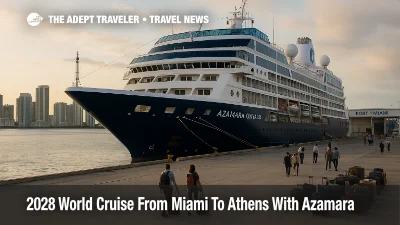
Manila Protests Block Roads And Airport Access Nov 30

Manila Protest March To Block Roads November 30, 2025

Verbena Cuts Sea Travel In Central Philippines November 24

Kalmaegi And Fung Wong Disrupt Flights In Southeast Asia

Philippines Ferries, Flights Halted by Fung Wong
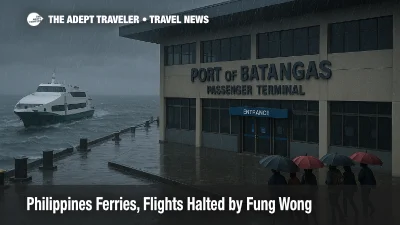
Fung Wong Disrupts Flights and Ferries, Taiwan Warnings Next

Super Typhoon Fung-wong Hits Luzon, Ferries Suspended

Typhoon Fung Wong Intensifies, Ferry Bans and Flight Risks
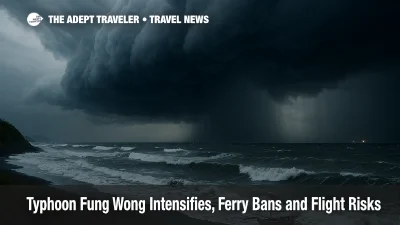
Philippines Emergency After Kalmaegi, Eyes 'Uwan' Next
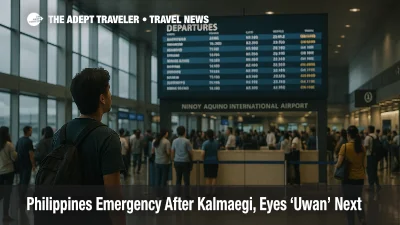
Global Guardian Flags Geopolitics as Top Travel Risk

Philippines earthquakes update: Mindanao doublet impacts

Super Typhoon Ragasa slams Luzon, upends regional travel

Typhoons Dante, Emong Prompt Philippine Flight Cancellations

Typhoon Emong, Storm Dante Snarl Philippines Air Travel

Typhoon Wipha Grounds Flights Across Vietnam

Tropical Storm Crising: What Travelers to the Philippines and Hong Kong Need to Know
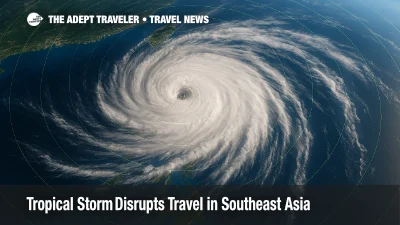
Is It Safe to Drink the Water in Asia? Comprehensive Guide

Best Times to Travel to Asia: Avoid Summer Crowds and Costs

